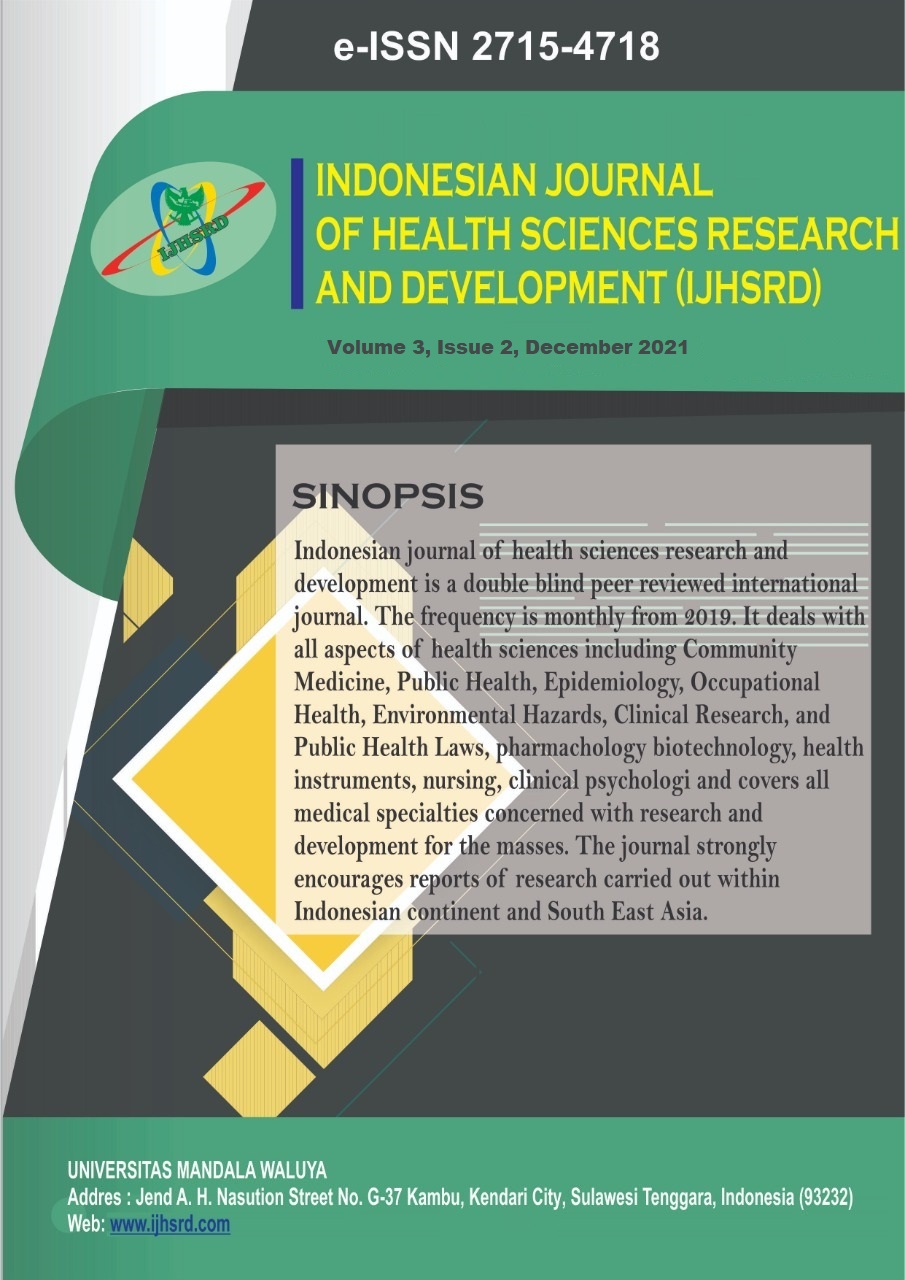Main Article Content
Abstract
Background: a recurrence of stroke, is a matter of concern because it can worsen the situation, increase the treatment costs, and increase death risk. Stroke recurrence caused by multifactorial cases. The objective of this study is to analyze the factors associated with stroke recurrence in the university of muhammadiyah malang hospital.
Methods: This study used a cross-sectional observation analytic study. A total sample of 64 people was collected using the purposive sampling technique. The dependent variable in this study was stroke recurrence. The independent variables were the factors that cause stroke recurrence (family history of the disease, comorbidities, physical activity, stress, and knowledge). This study used the Global Physical Activity Questionnaire(GPAQ), the International Stress Management Association(ISMA), and socio-demographic questionnaire to collect the data. The data were analyzed using the Chi-Square test.
Results: a total of 47 patients (73.43%) had stroke recurrence, the majority of the second recurrence. Most types of stroke were ischemic stroke (81.25%). The risk factor significantly associated with stroke recurrence was hypertension (sig 0.026 <0.05). Conclusion: Uncontrolled hypertension increases the process of atherosclerosis that can lead to bleeding and brain infarction.
Keywords
Article Details

This work is licensed under a Creative Commons Attribution-ShareAlike 4.0 International License.
References
- L. Asmedi, “Patofisiologi Stroke Hemoragik,” Badan Penerbit Fak. Kedokt. UGM, pp. 8–31, 2009.
- S. Alchuriyah and C. U. Wahjuni, “Faktor Risiko Kejadian Stroke Usia Muda pada Pasien Rumah Sakit Jiwa Rumah Sakit Brawijaya Surabaya,” Junal Berk. Epidemiol., vol. 4, no. June 2016, pp. 62–73, 2016.
- W. H. Organization., Stroke: A Global Response Is Needed, no. 6. 2016.
- O. Article, “Contributing Factors which led to Relapse of Tobacco‑Seeking Behaviour among Stroke Survivors, in a Selected Tertiary Care Hospital, New Delhi,” pp. 84–91, 2020.
- J. Chen et al., “Impact of Smoking Status on Stroke Recurrence,” J. Am. Heart Assoc., vol. 8, no. 8, 2019.
- F. Nurlan, “Analisis Survival Stroke Berulang Menurut Umur Dan Jenis Kelamin Pasien Stroke Di Kota Makassar,” Indones. J. Heal. Promot., vol. 3, no. 1, pp. 155–161, 2020.
- L. Wahyuni, E. Dwi, and D. Yasmara, “Jurnal Keperawatan Muhammadiyah 3(1) 2018,” Keperawatan Muhammadiyah, vol. 3, no. 2, pp. 1–15, 2018.
- P. A. Widyaswara Suwaryo, W. T. Widodo, and E. Setianingsih, “Faktor Risiko yang Mempengaruhi Kejadian Stroke,” J. Keperawatan, vol. 11, no. 4, pp. 251–260, 2019.
- X. Y. Yao et al., “Age- and gender-specific prevalence of risk factors in patients with first-ever ischemic stroke in China,” Stroke Res. Treat., vol. 2012, no. January 2004, 2012.
- C. L. Cleland, R. F. Hunter, F. Kee, M. E. Cupples, J. F. Sallis, and M. A. Tully, “Validity of the Global Physical Activity Questionnaire (GPAQ) in assessing levels and change in moderate-vigorous physical activity and sedentary behaviour,” BMC Public Health, vol. 14, no. 1, pp. 1–11, 2014.
- J. Chinawa, A. Chinawa, E. Aniwada, and O. Amadi, “Prevalence and Factors Associated with Susceptibility to Stress- related Illnesses Among Medical Students in a Nigerian Medical School,” ournal Taibah Univ. Med. Sci., vol. 20, no. 2, 2015.
- F. Shkëmbi, E. Melonashi, and N. Fanaj, “Workplace Stress Among Teachers in Kosovo,” SAGE Open, vol. 5, no. 4, 2015.
- P. G. Arun, J. Thayill, P. Shetty, and V. P. Ashwin, “Deep Relaxation Technique Improves Sleep Quality and Reduces Stress in Healthy Volunteers during Fasting Therapy,” IOSR J. Dent. Med. Sci., vol. 18, no. 12, pp. 56–62, 2019.
- Dharmawita, “Angka Kejadian Stroke Berdasarkan Usia Dan Jenis Kelamin Pada Stoke Hemoragik Dan Non-Hemoragik,” J. Med. Malahayati, vol. 2, no. 4, pp. 157–163, 2015.
- W. Wayunah and M. Saefulloh, “Analisis Faktor Yang Berhubungan Dengan Kejadian Stroke Di Rsud Indramayu,” J. Pendidik. Keperawatan Indones., vol. 2, no. 2, p. 65, 2017.
- M. Yousufuddin and N. Young, “www.aging-us.com AGING 2019, Vol. 11, No. 9,” vol. 11, no. 9, pp. 2542–2544, 2019.
- Y. Béjot et al., “Impact of the ageing population on the burden of stroke: The dijon stroke registry,” Neuroepidemiology, vol. 52, no. 1–2, pp. 78–85, 2019.
- M. Wajngarten and G. Sampaio Silva, “Hypertension and stroke: Update on treatment,” Eur. Cardiol. Rev. , vol. 14, no. 2, pp. 111–115, 2019.
- G. Friday, M. Alter, and S. M. Lai, “Control of hypertension and risk of stroke recurrence,” Stroke, vol. 33, no. 11, pp. 2652–2657, 2002.
- L. Castilla-Guerra and M. del C. Fernandez-Moreno, “Chronic management of hypertension after stroke: The role of ambulatory blood pressure monitoring,” J. Stroke, vol. 18, no. 1, pp. 31–37, 2016.
- Y. Wang et al., “Association of hypertension with stroke recurrence depends on ischemic stroke subtype,” Stroke, vol. 44, no. 5, pp. 1232–1237, 2013.
- M. Ushio, M. Kanaoka, Y. Kinoshita, S. Maeno, and K. Fujita, “Moderate-to-vigorous physical activity and the risk of stroke recurrence in patients with a history of minor ischemic stroke in Japan: a retrospective analysis,” Top. Stroke Rehabil., vol. 25, no. 8, pp. 591–598, 2018.
- G. Adientya and F. Handayani, “Stres Pada Kejadian Stroke,” Diponegoro J. Nurs., vol. 1, no. 1, pp. 183–188, 2012.
